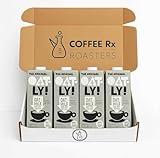There’s no question that coffee holds a cherished spot in our daily routines and cultures. Its aroma lures us out of bed in the morning, its rich taste provides comfort in the midst of a hectic day, and its caffeinated buzz offers the energy boost we sometimes desperately need. However, behind the simplistic façade of this beloved beverage lies a symphony of elements working harmoniously to deliver that perfect cup. One of these elements, often overlooked, is milk. You may wonder, does it really matter what type of milk you pour into your cup of joe? The answer is a resounding yes.
Welcome to our comprehensive guide on choosing the best milk for coffee. Whether you’re an occasional drinker, a home barista, or a coffee connoisseur, the information compiled here is designed to enhance your understanding and appreciation of the complex dance between milk and coffee. It goes beyond personal preference and delves into the science, ethics, and flavor profiles that will make every sip an experience. So, prepare to embark on a journey of discovery and learn how the right dairy can profoundly transform your coffee experience. Stay tuned and read on to uncover the secret to achieving the perfect brew!
Best Milk for Coffee: Key Takeaway
- The Science Behind Milk and Coffee: The fat and lactose content in milk play significant roles in shaping the texture and sweetness of your coffee, while temperature affects the interaction between milk and coffee.
- The Variety of Milk Types: From traditional whole milk to light skimmed and semi-skimmed alternatives, each type of milk brings a different nuance to your coffee. Plant-based alternatives like almond, soy, oat, and coconut milk offer dairy-free options with unique taste profiles.
- Methods to Combine Milk with Coffee: Whether it’s steaming and frothing for a latte, adding a dash to a cold brew, or creating classic espresso drinks like cappuccino, there’s an art to combining milk and coffee to create the perfect drink.
- Impact of Milk on Different Coffee Varieties: The type of coffee bean – whether it’s Arabica’s gentle flavors or Robusta’s strong profile – influences the milk-coffee dynamics, leading to different taste experiences.
- Ethical and Sustainable Choices: Choosing your milk involves more than just taste preferences; it also has ethical and environmental implications. Supporting ethical dairy farming, opting for vegan milk alternatives, and choosing coffee that adheres to sustainable and fair-trade practices contribute to a more responsible and sustainable food system.
The Science Behind Milk and Coffee
When it comes to the combination of milk and coffee, there’s much more than meets the eye. This seemingly simple pair involves a complex interplay of components that have a profound impact on your coffee’s taste and mouthfeel. So, let’s peel back the layers and examine the science behind this harmonious dance.
The Role of Fat in Milk: Creaminess and Texture

When discussing milk, one of the first things that comes to mind is its creaminess – a factor heavily influenced by the milk’s fat content. The fat present in milk contributes to the overall texture of your coffee in several ways:
- Body and Richness: The higher the fat content in the milk, the richer and fuller the body of your coffee becomes. This is why whole milk, with its high-fat percentage, often results in a creamier coffee than skimmed or semi-skimmed alternatives.
- Stability of Froth: The fat in milk plays a crucial role in the stability of froth for espresso-based drinks like cappuccinos or lattes. Fat molecules help to stabilize the air bubbles formed during frothing, leading to a dense, velvety foam.
- Flavor Carrier: Fat molecules in milk also act as carriers for flavor compounds present in coffee, enhancing the overall taste and allowing for a more nuanced flavor profile.
Lactose and its Impact on the Sweetness of Coffee

Another essential component of milk is lactose, a type of sugar that imparts a subtle sweetness. (1) Lactose’s presence in milk can significantly influence the taste of your coffee by balancing its inherent bitterness. Here are some points to consider:
- Natural Sweetener: Lactose provides a natural sweetness to coffee without the need for added sugar or artificial sweeteners. This sweetness can soften the coffee’s bitter notes, making it more palatable for those who find black coffee too strong or harsh.
- Maillard Reaction: When heated, lactose participates in the Maillard Reaction – a chemical reaction that leads to the browning of the milk and contributes to a richer, more complex flavor in your coffee. (2)
Temperature’s Influence on Milk and Coffee Interaction
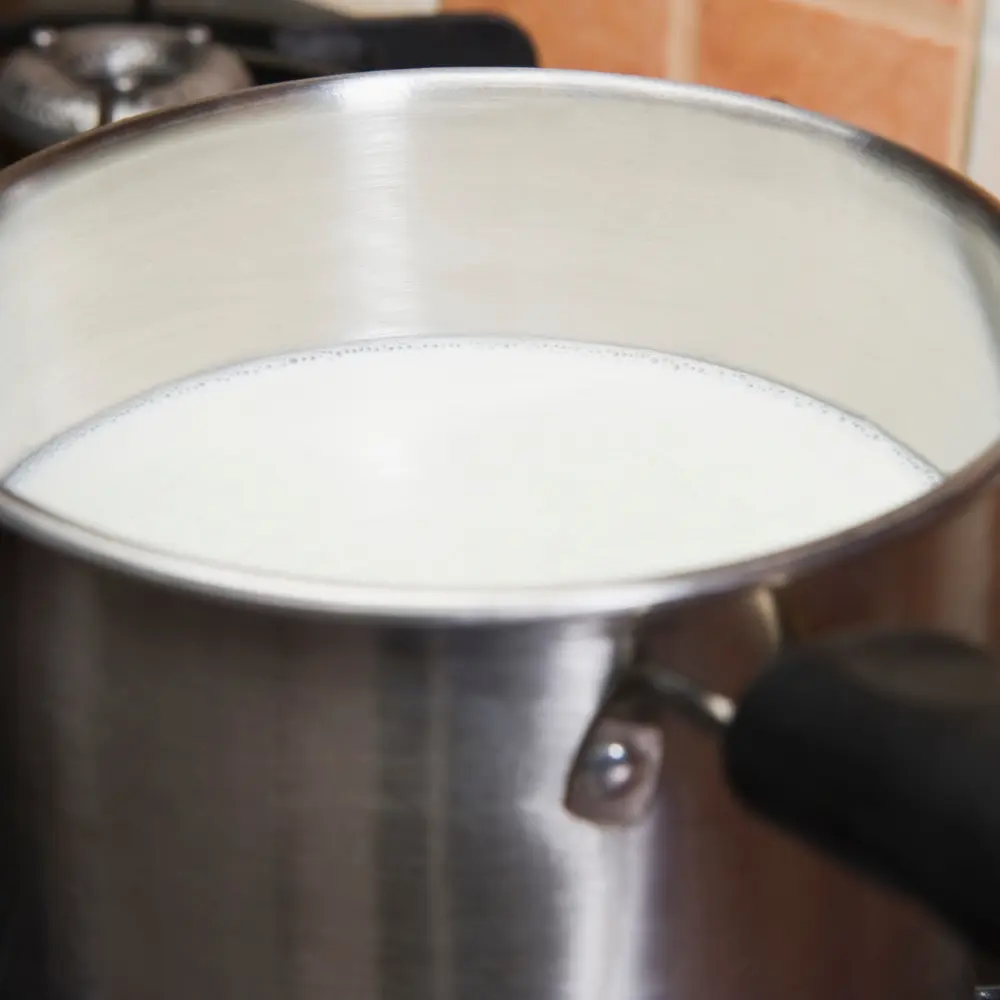
The temperature at which milk is served and combined with coffee can dramatically alter the final product. It’s not just about hot or cold; different temperatures unlock different characteristics in both the coffee and the milk:
- Steaming and Frothing: When milk is steamed or frothed for lattes and cappuccinos, the heat causes its proteins to unravel and its sugars to break down, creating a sweeter, smoother flavor profile and silky texture.
- Scalding: If milk is overheated, it can scald, resulting in a burnt taste that can overshadow the coffee’s flavor.
- Cold Milk and Cold Brew: On the other hand, using cold milk or adding milk to cold brew coffee can create a refreshingly cool drink with a distinctly creamy texture, without the sweetness produced by heating.
As we delve deeper into the world of milk and coffee, it’s evident that these two ingredients’ relationship is far more intricate than it may initially appear. By understanding these complexities, we can better appreciate every sip and curate a coffee experience that’s perfectly tailored to our tastes.
Types of Milk: How Do They Affect Your Coffee?
The variety of milk or milk alternatives you pour into your cup can greatly transform your coffee experience. Each type possesses unique characteristics – in terms of taste, texture, and nutritional content – that can complement or contrast your coffee’s flavor profile. Let’s explore the most common types and understand how they interact with your beloved brew.
Whole Milk: The Creamy Traditionalist’s Choice
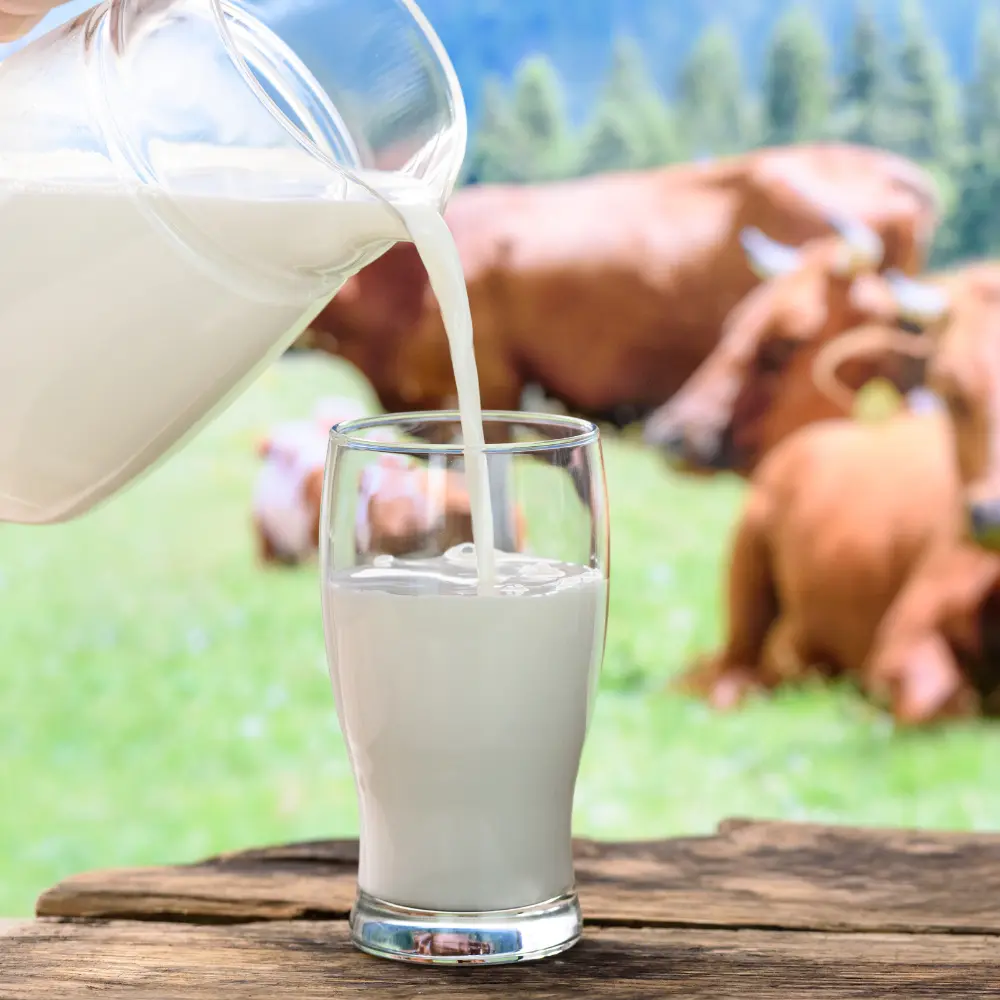
Whole milk has long been the traditional choice for many coffee enthusiasts and baristas alike. This is primarily due to its high-fat content, which lends a sense of fullness and richness to your coffee. Here’s what you need to know about whole milk:
- Creamy Texture: As discussed earlier, Whole milk’s high-fat content contributes to a creamy texture that’s cherished by many. It can help to balance the bitterness of the coffee, creating a harmonious blend of flavors.
- Froth Factor: When frothed, whole milk produces a dense and velvety foam, perfect for topping off your cappuccino or latte.
- Flavor Enhancer: The fat in whole milk also serves as a flavor carrier, helping to highlight the more subtle notes in your coffee.
Pros:
- Offers a rich, creamy texture that enhances the coffee body.
- Froths well due to its high fat and protein content, perfect for lattes and cappuccinos.
- The high-fat content can help to balance the acidity of the coffee.
Cons:
- Higher in calories and fat compared to other milk types.
- Not suitable for those on a low-fat or low-calorie diet.
- Ethical and environmental concerns related to dairy farming.
Skimmed and Semi-Skimmed Milk: Light and Frothy Alternatives

For those who prefer a lighter touch, skimmed and semi-skimmed milks offer a less fatty, more health-conscious alternative to whole milk. Here’s how they influence your coffee:
- Lighter Texture: These kinds of milk contribute a lighter body to your coffee, ideal for those who want to enjoy their coffee without the extra richness and calories of whole milk.
- Froth Quality: Due to their lower fat content, skimmed and semi-skimmed milk tend to produce a larger volume of froth, but it may be less creamy and less stable than whole milk.
- Sweeter Taste: Skimmed and semi-skimmed milks contain more lactose (since the fat content is reduced), making your coffee slightly sweeter when heated.
Pros:
- Lower in calories and fat than whole milk, making it a lighter option.
- Can still create a decent froth for coffee drinks, particularly semi-skimmed.
- Less likely to mask the coffee’s natural flavors due to lower fat content.
Cons:
- Lacks the creamy richness of whole milk, which can affect the texture of coffee.
- Froth tends to be less stable and dissipates quicker than whole milk.
- The taste can be less satisfying for some people as it’s less creamy.
Plant-Based Milk: Almond, Soy, Oat, and More
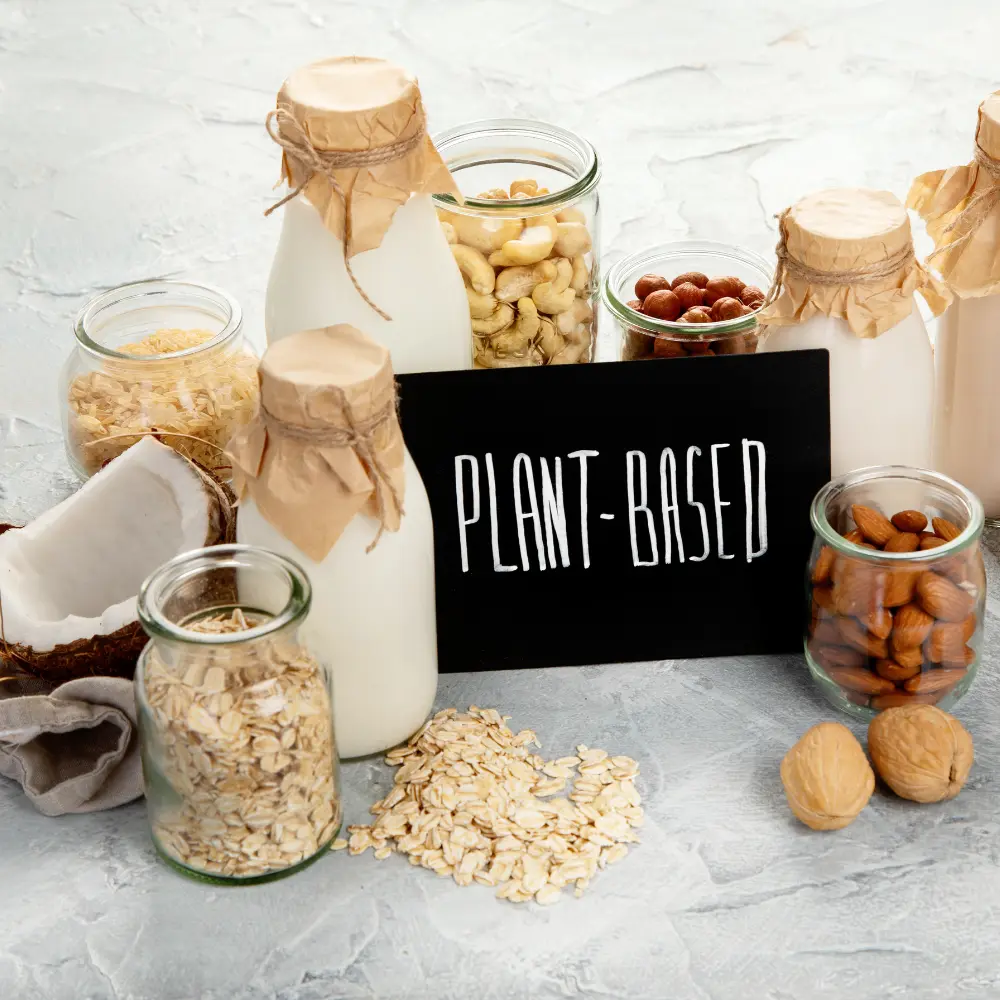
With dietary preferences changing and increasing awareness of sustainability, plant-based milks have become a popular alternative. Almond, soy, and oat milk are among the most common choices, but others like coconut milk for coffee are also gaining popularity.
Almond Milk
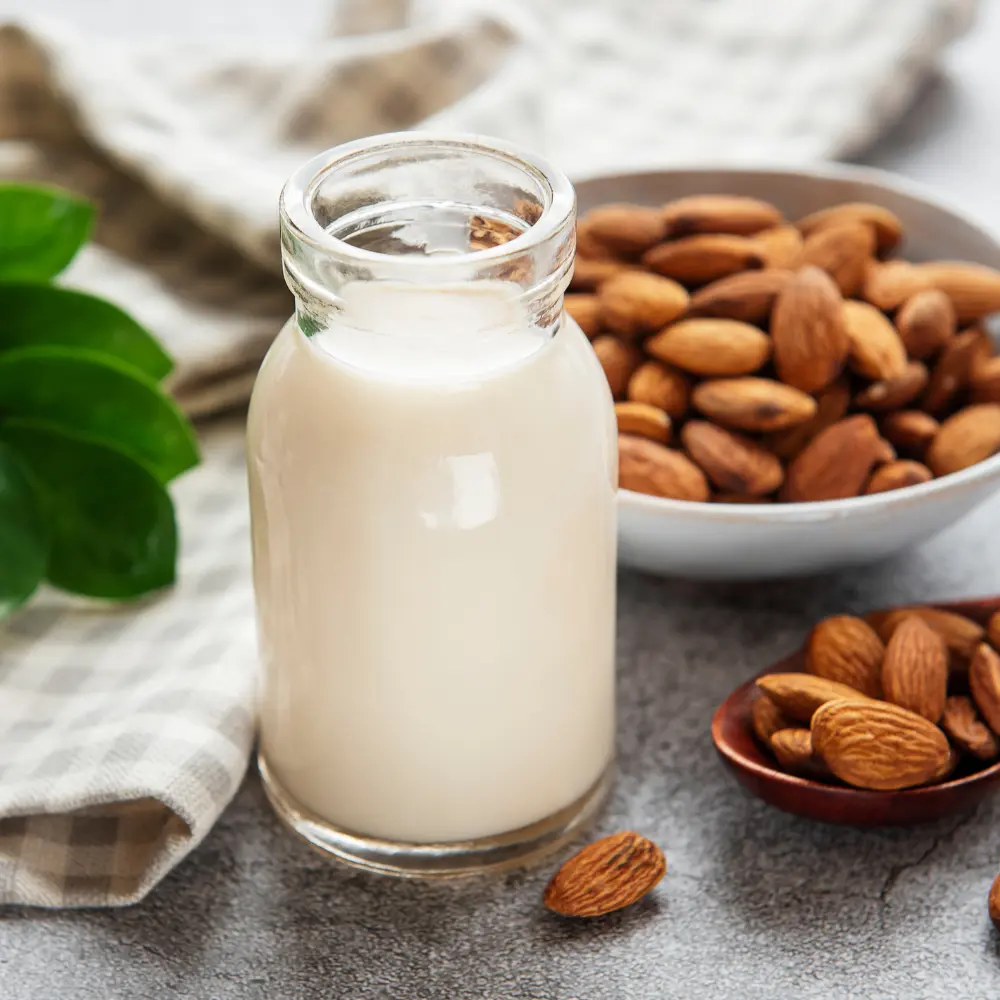
Made by blending almonds with water and then straining the mixture, almond milk has a light body and a slightly sweet, nutty flavor that can add a new dimension to your coffee. Despite its attractive taste profile, almond milk is lower in protein and fat compared to dairy milk. This means that when you try to froth almond milk, it might not hold up as well, often resulting in larger bubbles and less stable foam. However, it’s worth noting that this can vary among brands, and some almond milk variants specifically designed for baristas can froth better.
Pros:
- Lower in calories than most dairy and other plant-based milks.
- Nutty flavor can add a unique taste to coffee.
- Usually enriched with calcium and vitamins D and E.
Cons:
- May not froth as well due to low protein and fat content.
- The nutty flavor may not be to everyone’s liking.
- Not the most sustainable choice due to the high water needs for almond farming.
Soy Milk

Soy milk is made from soaked and ground soybeans, and it’s one of the most nutritionally balanced dairy alternatives, boasting a good amount of proteins. It possesses a creamy consistency that’s quite similar to dairy milk, making it a popular choice for coffee drinkers. The taste of soy milk is relatively neutral, allowing it to blend well with coffee without overpowering its flavor. Additionally, due to its protein content, soy milk can create a decent foam when frothed, although it may not get as velvety as dairy milk.
Pros:
- The creamy texture and neutral taste make it a good dairy substitute.
- High in protein, which aids in good frothing for coffee drinks.
- Often fortified with vitamins and minerals.
Cons:
- Some people may have a soy allergy or sensitivity.
- Genetically modified soybeans are a common concern.
- Flavor can sometimes be described as ‘bean-like’, which might not complement all coffee types.
Oat Milk
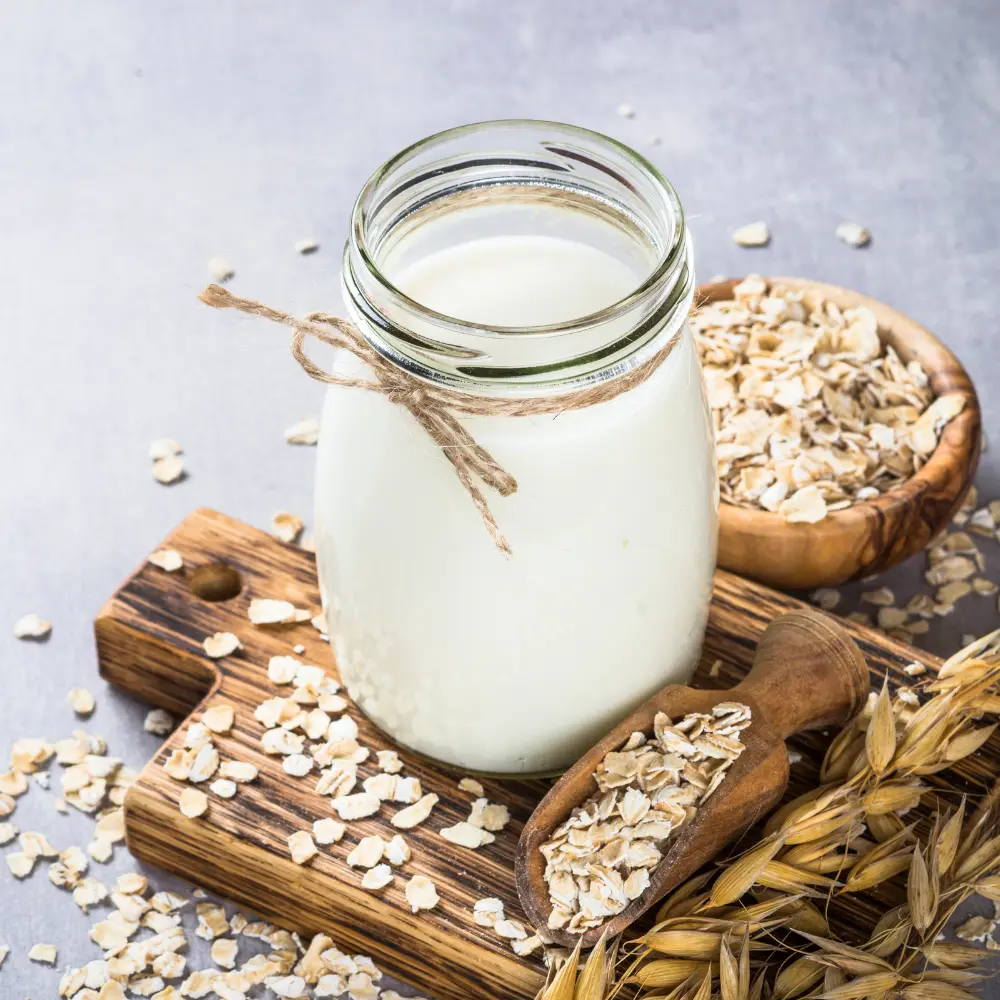
Made by soaking oats in water, blending the mixture, and then straining it, oat milk offers a slightly sweet, mild flavor that goes well with coffee. It has a creamy texture that mimics dairy milk quite closely, even more so than most other plant-based alternatives. As such, oat milk is often hailed as the best milk substitute for coffee, especially for lattes and cappuccinos. It also froths well, producing a rich, creamy foam that adds an indulgent touch to your coffee. Just bear in mind that its natural sweetness can alter the flavor of your coffee a bit.
Pros:
- Often considered the best plant-based milk for coffee due to its creamy texture and neutral flavor.
- Good for frothing, making it a favorite in many coffee shops.
- Environmentally friendly due to low water usage in oat farming.
Cons:
- Higher in carbohydrates and calories compared to other plant-based milks.
- Can make coffee taste slightly sweeter, which may not be preferred by all.
- Quality can vary greatly between brands.
Coconut Milk
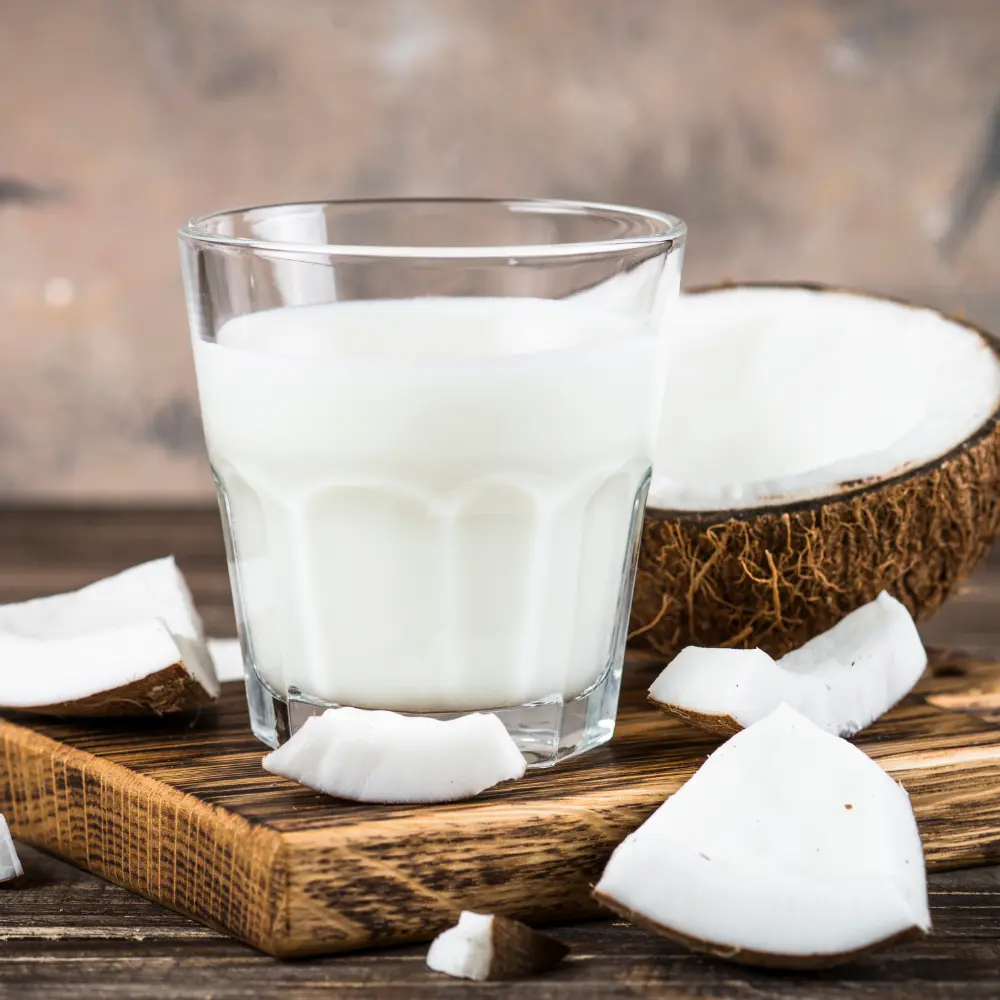
Made from the grated meat of mature coconuts, coconut milk introduces a distinctly rich, tropical flavor to your coffee. Its creamy, velvety texture can give your coffee a luxurious feel. However, its strong, unique taste might mask some of the delicate flavors in your coffee. As for frothing, coconut milk can create a light, airy foam, but it may not get as thick or stable as dairy or some other alternatives.
Pros:
- Rich, creamy texture can enhance the coffee body.
- Tropical flavor can add an interesting twist to coffee.
- Lower in carbohydrates than many other milk alternatives.
Cons:
- Strong flavor can overwhelm delicate coffee notes.
- Can have a slightly oily mouthfeel.
- Doesn’t froth as well as dairy or some other plant-based milks.
Rice Milk
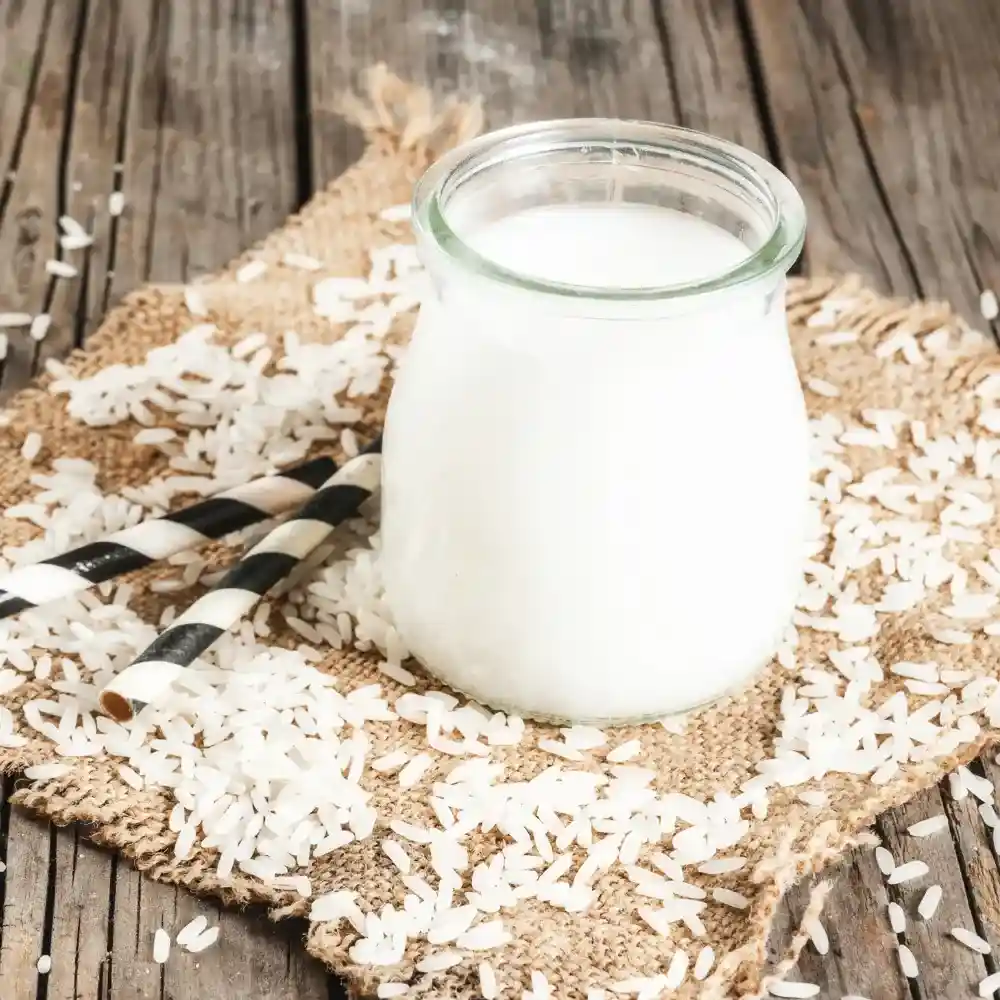
Produced from milled rice and water, rice milk is naturally sweeter and thinner compared to other milk alternatives. While it may not be the best option for frothing due to its low protein and fat content, the inherent sweetness of rice milk can balance the bitterness of coffee, lending a pleasant taste without adding any extra sugar. However, because of its watery consistency, it might not provide the creamy texture that some coffee lovers seek.
When exploring these plant-based alternatives, it’s essential to consider how their unique characteristics might affect your coffee experience. Keep in mind that the impact on taste and texture can also depend on the coffee type and brewing method you choose.
Pros:
- Naturally sweeter flavor can complement certain coffee styles.
- Hypoallergenic, making it a good choice for those with allergies to dairy, nuts, or soy.
- The light texture doesn’t alter the coffee consistency much.
Cons:
- The thin texture makes it unsuitable for frothing.
- High in carbohydrates and relatively low in protein.
- Environmental concerns related to water use in rice farming.
Best Methods to Combine Milk with Coffee
Combining milk and coffee is an art form, a delicate balance of temperature, timing, and technique that can greatly impact your coffee experience. While adding a splash of cold milk to a cup of hot coffee is a common practice, several other methods elevate the coffee-milk interaction to new heights. Let’s explore some of the best ways to marry these two ingredients and create a delightful symphony of flavors and textures.
Art of Steaming and Frothing Milk
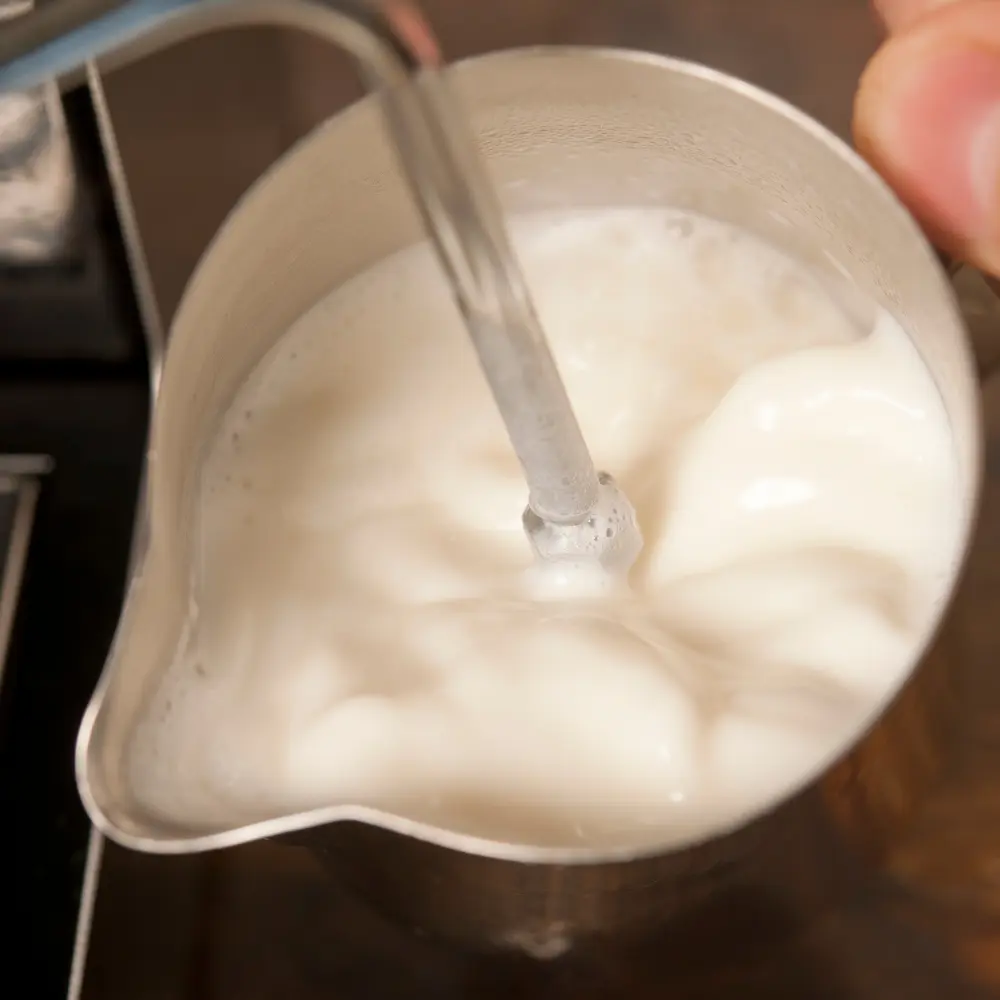
Steaming and frothing milk for coffee is a skill often associated with baristas, but with a bit of practice, you can master it at home. The process involves heating the milk and incorporating air to create a creamy, foamy texture.
- Steaming: Steaming involves heating milk using the steam wand of an espresso machine. The steam heats the milk and creates a small amount of micro-foam on the surface. Steamed milk is typically used in lattes, where the focus is on the creaminess of the milk rather than the foam.
- Frothing: Frothing, on the other hand, involves more vigorous aeration, creating a larger volume of foam suitable for cappuccinos. While frothing can be done with a steam wand, handheld frothers are also effective.
- Micro-Foam vs. Macro-Foam: The aim is to create micro-foam – a silky, glossy foam made of tiny air bubbles that seamlessly integrate into the milk, providing a velvety mouthfeel. Macro-foam, with larger, less uniform bubbles, lacks the creamy texture of micro-foam.
Remember, achieving the perfect froth requires careful attention to the milk’s temperature. Overheating can lead to scalding, which will spoil the milk’s natural sweetness and result in a burnt taste.
The Cold Brew with Milk: A Summer Treat

For those hot summer days when a piping hot coffee isn’t appealing, cold brew coffee with milk is a refreshing alternative.
- Making Cold Brew: Cold brew is made by steeping coarsely ground coffee in cold water for an extended period, typically 12-24 hours. This slow brewing process results in a coffee that’s smooth, low in acidity, and full of nuanced flavors.
- Adding Milk: You can add cold milk to your cold brew to create a creamy, refreshing coffee drink. The milk not only adds a creamy texture but also balances the robustness of the cold brew, making it smoother and sweeter.
- Customizing Your Drink: Depending on your preference, you can add just a splash of milk or enough to make your cold brew a creamy iced latte. For a touch of sweetness, consider using sweetened vanilla almond milk or oat milk.
Milk in Espresso: Creating Classics like Latte and Cappuccino

Espresso-based drinks like lattes and cappuccinos showcase the beautiful harmony between milk and coffee. Both these drinks involve combining espresso with steamed milk, but the proportion and treatment of milk make each one unique.
- Latte: A latte consists of one shot of espresso, steamed milk, and a small layer of milk foam on top. The larger quantity of milk in a latte makes it creamier and less strong compared to other espresso-based drinks.
- Cappuccino: A classic cappuccino is an equal three-part harmony of espresso, steamed milk, and frothed milk. The larger proportion of foam gives the cappuccino its distinct airy texture and strong coffee flavor.
Mastering the art of adding milk to your coffee can significantly improve your home-brewing experience. It’s all about experimentation
The Science Behind Non-Dairy Milk Separation in Coffee
Non-dairy milk curdling in coffee is a common occurrence that can puzzle and potentially put off some coffee enthusiasts. The key to understanding why this happens lies in the fundamentals of chemistry and the unique properties of plant-based milks and coffee.

To start with, coffee is naturally acidic, with a pH typically ranging from 4.85 to 5.10. When an acidic substance, like coffee, is mixed with plant-based milk, it can cause the proteins in the milk to coagulate or ‘curdle,’ creating an unappealing visual effect. This curdling effect is generally more pronounced in fresh, hot coffee due to its higher acidity and temperature.
Different types of plant-based milk can react differently, however. For instance, one may wonder: Does oat milk curdle in coffee? While oat milk can curdle under certain circumstances, it’s generally considered one of the most stable plant-based milks in coffee due to its unique fat and protein composition. It’s also why you’ll often find oat milk as a preferred non-dairy option in many coffee shops.
There are a few tips to minimize curdling:
- Cool down your coffee before adding plant-based milk. A lower temperature can reduce the curdling effect.
- Try adding your plant-based milk to the cup first, then slowly pour in the coffee. This more gradual change in temperature and acidity can help prevent curdling.
- Ensure your plant-based milk is well-shaken and fresh. Old or improperly stored milk is more likely to curdle.
Remember, even if your plant-based milk does curdle in your coffee, it’s generally safe to drink and doesn’t significantly affect the flavor. It’s more of a visual and textural issue than a taste one.
Impact of Milk on Different Coffee Varieties
Just as the type of milk you choose affects your coffee’s taste and texture, the type of coffee bean you use also influences the milk-coffee dynamics. The two most popular coffee species, Arabica and Robusta, have different taste profiles and react differently with milk. Let’s delve into the impact of milk on these coffee varieties.
Milk and Arabica: A Gentle Combination

Arabica beans, accounting for about 60% of the world’s coffee production, are prized for their delicate, nuanced flavors. With their typically mild, slightly sweet, and acidic profile, Arabica beans often exhibit notes of fruits, berries, and chocolate.
- Complementing Flavors: When paired with milk, the gentle flavors of Arabica can be complemented without being overpowered. Milk’s creamy texture and slight sweetness can soften the coffee’s acidity and highlight its subtle flavors.
- Balance is Key: However, balance is crucial. Too much milk can dilute the delicate flavors of Arabica. Consider using less milk or choosing a less fatty milk option to maintain the coffee’s character.
- Ideal for Lattes and Flat Whites: Given their harmony, Arabica coffee beans and milk form the base for popular drinks like lattes and flat whites, where the coffee’s flavors are enhanced rather than masked by milk.
Milk and Robusta: A Strong Fusion

Robusta beans, with their bold, robust flavor profile, provide a stark contrast to Arabica. Known for their high caffeine content and low acidity, Robusta beans typically have a stronger, more bitter taste, often with nutty or chocolatey notes.
- Milk as a Counterbalance: Adding milk to Robusta coffee can help counterbalance its robustness. The creaminess and natural sweetness of the milk can smooth out the coffee’s bitterness and make it more palatable.
- Full-Fat Milk for Robusta: Full-fat milk can stand up to the strong flavors of Robusta better than skimmed or semi-skimmed milk. The high-fat content enhances the coffee’s richness and creates a well-rounded taste.
- Perfect for Espresso-Based Drinks: Due to its strength and full-bodied flavor, Robusta is commonly used in espresso-based drinks, including those with a significant milk component like cappuccinos and macchiatos.
The Flavor Matrix: Understanding Milk-Coffee Pairings

Understanding the flavor matrix of milk-coffee pairings can significantly enhance your coffee experience. Here are a few pointers:
- Harmony of Flavors: Always aim for a harmony of flavors where the milk complements the coffee instead of masking it. Different milk types and coffee varieties will interact in unique ways, adding depth and complexity to your drink.
- Experiment with Ratios: Experiment with different ratios of milk to coffee. While some coffee types might require more milk to balance their strong flavors, others might need less so as not to dilute their delicate notes.
- Consider the Brew Method: The brewing method can also influence how milk and coffee interact. Espresso-based drinks, for instance, may benefit from the creaminess of full-fat milk, while cold brews might pair better with a lighter milk or dairy alternative.
To sum up, finding the perfect milk and coffee pairing comes down to personal preference. By understanding how different factors influence the final brew, you can find a combination that best suits your palate.
Ethical Considerations: The Dairy Industry and Sustainable Coffee
Our choices as consumers don’t just affect our taste buds; they also have far-reaching impacts on the environment, economy, and societies at large. When it comes to selecting the best milk for your coffee, understanding the ethical implications of your choices can help promote sustainability and ethical practices in both the dairy and coffee industries.
Ethical Dairy Farming: What Does It Mean for Your Milk?

Ethical dairy farming focuses on the welfare of the animals, fair treatment of dairy farmers, and sustainable farming practices that minimize environmental impact. But what does it mean for your milk?
- Animal Welfare: Ethical dairy farms prioritize the health and well-being of their animals. This not only includes providing adequate living conditions but also ensuring a humane approach to milking.
- Farmer’s Rights: These farms also safeguard the rights of farmers by providing them with fair wages and safe working conditions.
- Sustainable Practices: Ethical dairy farming incorporates sustainable practices, like efficient waste management and responsible land use, which help reduce the environmental footprint of milk production.
Choosing milk from ethical dairy farms not only supports these practices but can also impact the quality of your milk. Happier, healthier cows generally produce better-quality milk, which can enhance your coffee experience.
The Rise of Vegan Milk Alternatives
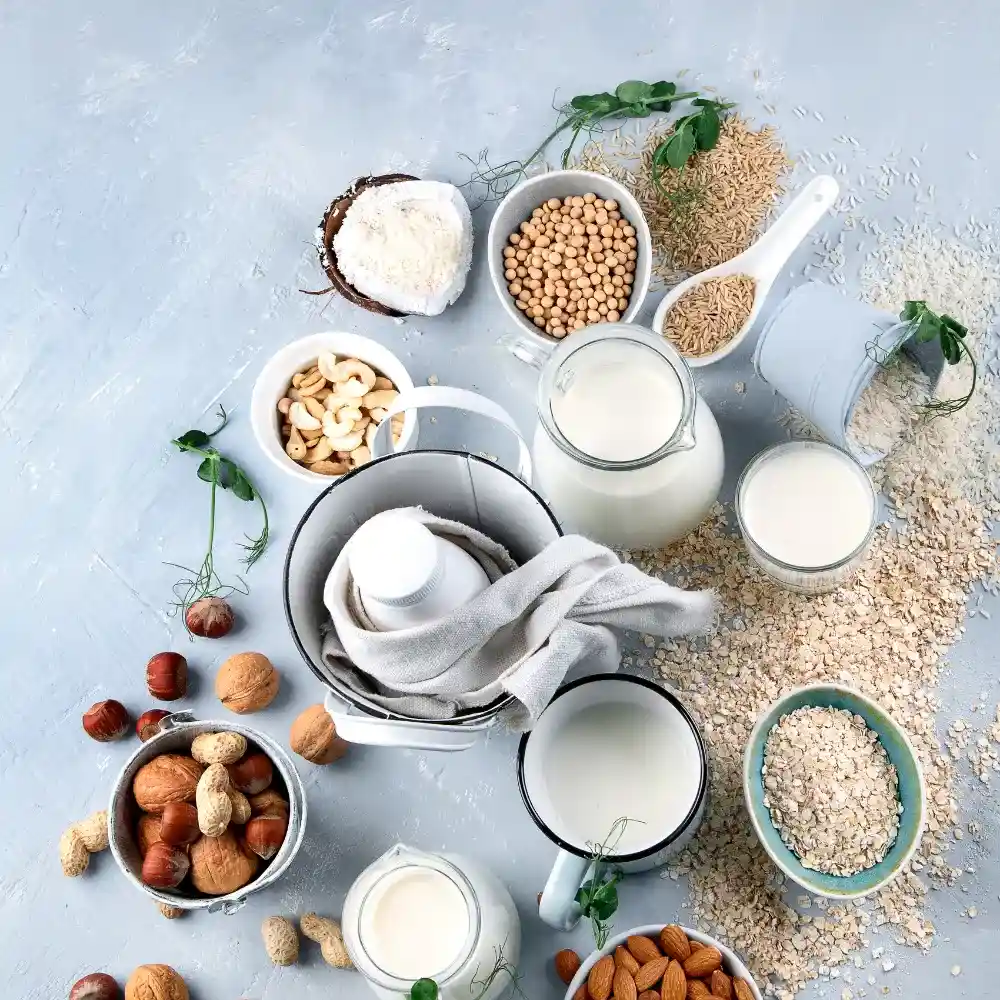
With growing awareness of the environmental and ethical concerns associated with dairy farming, many consumers are turning to plant-based milk alternatives. These vegan-friendly options, such as almond, soy, oat, and coconut milk, offer a way to enjoy the creaminess of milk in your coffee without the associated dairy impact.
- Lower Environmental Impact: Most plant-based milk alternatives have a lower environmental footprint than dairy milk in terms of water usage and greenhouse gas emissions.
- Increased Biodiversity: Different crops used for milk alternatives contribute to agricultural diversity, potentially reducing soil erosion and promoting biodiversity.
- Health Benefits: Many plant-based milks offer unique health benefits, like the heart-healthy fats in almond milk or the high fiber content of oat milk.
However, it’s important to remember that not all plant milks are created equal. Factors such as water usage, land use, and local impacts can vary, so it’s always a good idea to research your chosen milk alternative.
The Future of Coffee: Sustainable and Fair-Trade Practices
Just as with milk, the coffee industry also faces significant ethical and environmental challenges. As coffee lovers, supporting sustainable and fair-trade practices can contribute to a more sustainable coffee future.
- Sustainable Farming: This involves practices like shade-grown coffee, which helps preserve forest habitats, and organic farming, which minimizes the use of harmful pesticides and fertilizers.
- Fair Trade: Fair-trade coffee ensures that coffee farmers receive fair wages and work in safe conditions. It also often involves investing in local communities to promote long-term economic sustainability.
- Direct Trade: This model involves coffee roasters buying directly from growers, cutting out the middlemen, and ensuring a fair price for farmers.
By choosing ethically sourced coffee and dairy or plant-based milks, we can contribute to a more sustainable and fair food system, all while enjoying a delicious cup of coffee.
Conclusion
In conclusion, the quest for the best milk for coffee is a journey that extends beyond mere taste and preference. It dips into the realms of science, exploring the unique interaction between milk and coffee, and investigates how factors such as fat content, lactose, and temperature influence the texture and flavor of your cup. This exploration also brings us face-to-face with an array of choices, from the traditional full-fat dairy milk to the increasingly popular plant-based alternatives, each offering a different twist to our beloved coffee.
Yet, choosing the best milk for your coffee isn’t just about enriching your coffee experience. It’s about making conscious choices that respect our environment and society. It’s about understanding the implications of our choices on the dairy and coffee industries and aligning our consumption habits with practices that promote sustainability, fairness, and ethical treatment of animals and farmers.
So the next time you reach out to add a dash of milk to your coffee, remember that you’re not just enhancing your beverage. You’re participating in a global conversation about food ethics, industry practices, and sustainability. The best milk for coffee then becomes not just about taste, but also about the impact of our choices. And that’s a conversation worth having over a good cup of coffee.
FAQ
How do different types of milk affect the taste of my coffee?
Different types of milk, including whole, skimmed, semi-skimmed, and plant-based alternatives, each offer unique taste profiles and textures, hence influencing the taste and feel of your coffee differently.
What are the best methods to mix milk with coffee?
Steaming and frothing milk for espresso-based drinks, adding a splash to a cold brew, or mixing it in classics like lattes and cappuccinos are some of the best methods.
How does milk influence the flavors of different coffee varieties?
Milk interacts differently with various coffee varieties, complementing the gentle flavors of Arabica or counterbalancing the robustness of Robusta, thus altering the overall flavor profile.
What are the ethical considerations when choosing milk for coffee?
Choosing milk involves considering animal welfare in dairy farming, the environmental impact of milk production, and supporting the rise of vegan milk alternatives for their lower environmental footprint.















